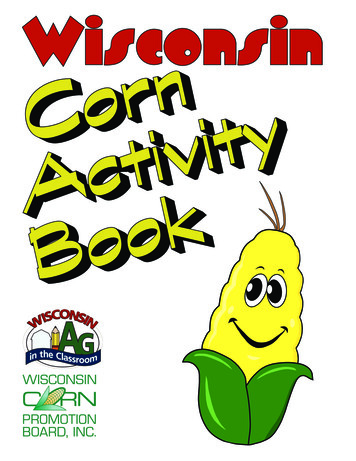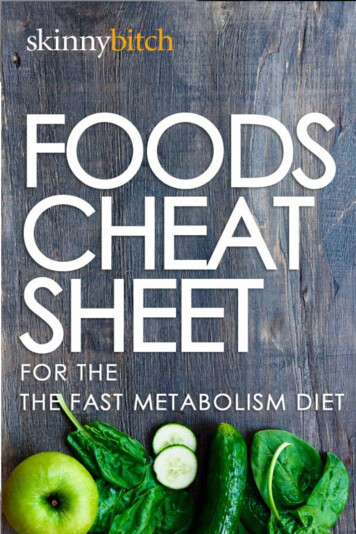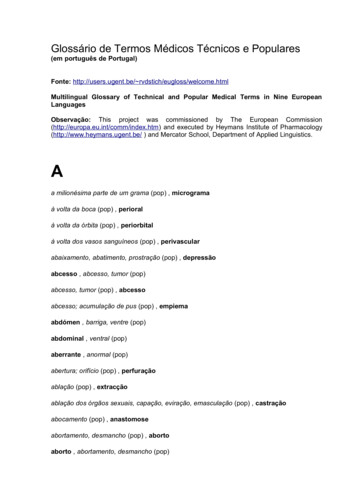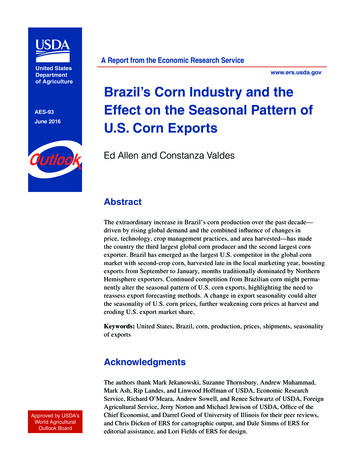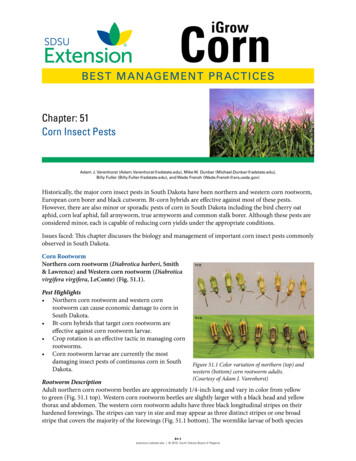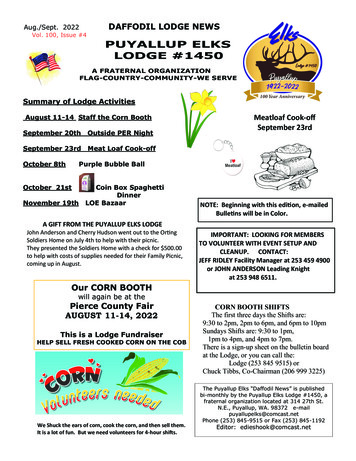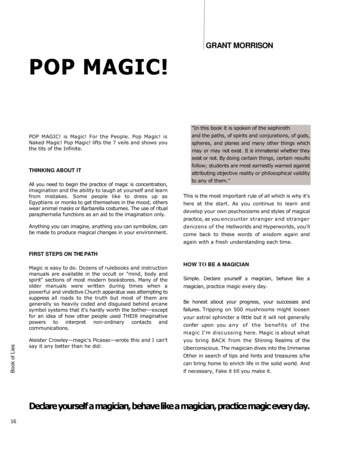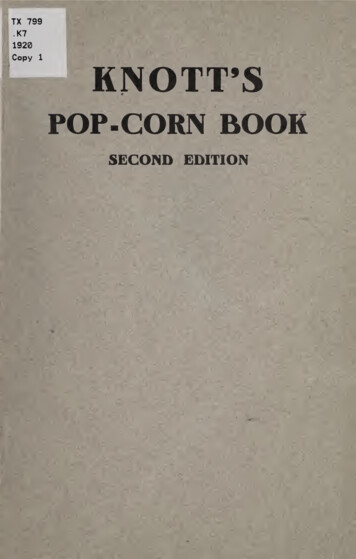
Transcription
KNOTT’SPOP-CORN BOOKSECOND EDITION
*v*‘ tjs"v .L"'-'- ? .*r. ?. .T* ;‘v-- ' *S‘‘ ' ' . 4*5v:-./ (V*- -./" ,? ::- ‘T‘r'; cv.' .''V, ';rj ' ,,\."\::-f?H-C."'1'c.-? r-‘W1:- :r,A‘-’ Jj- *. :.« V:w - .'- SSh-.a '. " #-7'--4 - v:*- %r-. .- -- -. -V r?iC ; /;.v'’S' - * . ' ' '‘-4ftr :'Sr--- t.'
KNOTT'SPOP-CORN BOOKDEDICATED TOTHE HEALTHTHE HAPPINESSTHE WEALTHOF ALL PEOPLECONTENTS:Pop-Corn, the Grain and its HandlingThe Popping of CornFactory PlanningThe Right Way to Handle the BatchWhat to do with Corn that Does Not PopRa w MaterialsPaper and PackagesThe Cooking of SyrupRecipes and FormulasDistributionNational Confectioners’ AssociationHow to Figure CostsPop-Corn MachineryCOMPILED BYE, R.KNOTT IPUBLISHEDBYE. R. KNOTT MACHINE CO.BOSTON,MASSACHUSETTS
Copyrighted, 1920By E.R.KNOTTMAR -1 1920§ CI.A559896
(j z q/ 3u7 / WHENBETTERMACHINESKNOTTWILLPOP-CORNAREMADEMAKETHEM
The Illustration in Col orsYou see a few of the many attractive styles in which you can putup pop-corn made on Knott’s Pop-Corn Machines.The top package, a pop-corn brick, is extensively sold from Maineto New Jersey along the Atlantic coast at beaches and parks in summer.The center picture of bar pop-corn, either ground or whole, is aNew England favorite.The top bar has the paper folded back as it isheld while eating by biting off the bar.The lower left is a package of whole corn fritters or crispettes, whileat the right is shown a crispette on top of some ground corn fritters.The center upper piece is called “two-fers” because it sells twofor a penny.Jt is a New England piece.The lower center is a pennycake.These last four pieces are winter goods.The flavors are Molasses (yellow), Chocolate (brown), Vanilla(white), Checkerberry or Wintergreen (pink).
Knott’s Pop-Corn Book5This Book has been Printed: —(1) Because now is the time to enter into the manufacture ofpop-corn.(2)Because every district will soon have its pop-corn factory.(3) Because your customers will realize that only goods of localmanufacture and high quality, under your trade-mark, are dependablyfresh and wholesome.(4)Because people are buying more pop-corn than ever before.(5)Because the demand for pop-corn ground and whole, in squares,bars, fritters, etc., in New England is as substantial as the demand forcrackers.(6) Because pop-corn has great possibilities.(7) Because pop-corn may be put before the public in many ways.(8) Because if one style is not salable in a certain locality thereare enough that will be, as there are plenty of styles to choose from.(9) To show that you should trade-mark your goods.(10) To show that the “price toboggan” had better coast empty.(11) To give you guidance, so that no matter what may be yourproblem you may eventually achieve success.(12) Because pop-corn makers are scarce as compared to thedemand for them, and it is hoped that this will assist in the training ofcapable men.(13) Because pop-corn made on quality builds business.(14) Because we want to increase the consumption of pop-corn.This is the kind of a book that you get properly balanced in yourmind if you read it three times, one after the other. Even after thethird time you will find something that you passed over without noticingat the other readings.
6Knott’sPop-CornCHAPTERBookITHE WORLD-WIDE FOOD-CONFECTIONAFTER every man, woman and child gets to know its pleasant tasteand its food value, the world consumption of pop-corn is going tobe something tremendous.Consider that pop-corn contains the whole of thegrain, and that the grain is thoroughly cooked. It is ahealthful, nourishing food. It is pure.It is a poorman’s confection and food combined. It is too pala table for the rich man to ignore. It is considered by“Uncle Sam” to be such a valuable article that throughthe United States Agricultural Department, he has pub lished two pamphlets for free distribution, Farmers’Bulletins No. 553, “Pop-corn for the Home,” and No.554, “Pop-corn for the Market.”By permission ofthe department we avail ourselves of some of the in formation there given.The earUnpopped Kernels and Popped Kernels of White Rice Pop- Corn(With Permission of the U. S. Department of Agriculture.)Out of the more than twenty varieties of pop-corn you are advisedto use \\ hite Rice, as that makes the largest popped kernel comparedto the size of the raw kernel, and it is the most common commercialpop-corn.As it is the expanding of the moisture in pop-corn by turning intosteam that explodes and cooks the grain, it is necessary to have the rightquantity of moisture, about twelve per cent., and to have that moistureevenly distributed throughout the kernel, and the kernel otherwise infit condition for popping.Some of the things that spoil the popping quality of corn are:# Seed from which the crop is raised not being acclimated to the local ity in which it is planted.Other kinds of corn growing near the pop-corn.Picking before the pop-corn has fully ripened, or picking after thecoming of frost.Not sufficient ventilation while curing.
Knott’sPop-CornBook7Too much drying out; shelled corn dries out faster than corn onthe cob.Shelling the corn too long before popping.Defects in the kernel itself.Damage from moths which produce weevils.Insufficient heat, giving poor popping results.You see that it is really a delicate proposition to deliver pop-cornto you that will give you the best results. Therefore, it is not safe foryou to buy pop-corn of any but reliable dealers.Seventy pounds of ears, air-dried, constitute a bushel.Fifty-six pounds of shelled pop-corn make a bushel.One hundred pounds of ears should give eighty pounds of shelledpop-corn.There are the same number of food units in:—One brick of Pop-corn.One-hfth of a pound of Roast Beef.Four servings of Oatmeal.Four Eggs.One-third pound Roast Lamb.One pint Milk.To be more accurate, here is the percentage of proteid, fat, carbo hydrates and the number of calories in one pound of each of the ,Oatmeal (boiled),Roast Beef,Eggs,Roast ories256018571860280016003001800760900300
8Knott’s Pop-Corn BookThis chart of manufacturing process shows at what point each in gredient enters the batch.It shows the arrangement of operations.It shows what type of goods is the easiest to make and what takesthe most machinery to complete. It condenses on one page the under lying principles of pop-corn confection manufacture.Study it carefully. In this chart you will find the answer to yourquestion of how to arrange your factory—at what point in the work acertain material is added to the confection.It shows what materials are required to manufacture pop-corn con fection and shows what set of machines are necessary to make a partic ular type of corn confection.It shows what machines are the essential ones in the business.
Knott’sPop-CornBookChart of Manufacturing Procedure9
Dodgers, various colors and flavorsCrispettes, various colors and flavorsXXXXXXXTwo Stock Tanks No. 2013-1 Page 25XXXXXXXMeasure 2 qt. GraduatedPaddle No. 1006-1 Page 41XXXXXXXXXX 5 Transfer Racks No. 2022-1 Page 35X5 Pans No. 2007-1 Page 31XXButtered Corn Tank No. 2019-1Page 41XWrapping Form Page 31XCrispette Machine S F 3 Page 38XBiscuit Mould No. 2002-1 Page 31X5 Biscuit Pans No. 2007-2 Page 31SCHEDULE OF EQUIPMENTBiscuits, various colors and flavorsXSalted Pop-CornPenny Squares and BarsXButtered Pop-CornBricksXXXXXXXXXStove No. 113-1 Page 25XXXXXXXXMixer No. 114-2 Page 29XXThis schedule illustrates in a different way from the “Chart of Manufacturing Procedure” on page 9 what you require as anequipment for the manufacture of any one of the regular types of Pop-Corn Confection.Pop-Corn Bars, “Penny Squares and Bars” as the line is called, requires as you see by the X’s, these machines—Popper, Sifter,Stock Tanks, Measure, Stove, Mixer, Grinder, Press, Cutting Machine, 5 Pans—thus you get a definite list of the tools for a completeplant, for the particular product.SticksXSifter No. 112 Page 20Brittle5 Stick Pans No. 2007-3 andMould No. 2002-4 Page 39XCutting Machine No. Ill Page 35Cutting Machine No. 115 Page 37XPress No. 110-1 Page 33XXXGrinder No. 109-1 Page 22XXXXXxXXPopper No. 2002-3 Page 19XXXXx!XBookPop-CornKnott’s10
Knott’sPop-CornCHAPTERYBook11IIPROCESS OF MANUFACTUREOU, when you first tasted a delicious brittle kernel of Pop-corn,coated thinly with candy, you did not think of the skill attained bypractise, the skill that was necessary in order that your piece ofpop-corn confection might have the right amount of candy on each ker nel of pop-corn and the kernel be of its original full-sized fluffiness.It is an operation that appeared to you as simple and easy of ac complishment when you first saw it performed in the hands of an expert.Then when you tried it? Well, you had “An experience.”Y ou found that somehow the corn did not act for you the same asfor him.It did just what you did not expect it to do. It formed into onebig ball of condensed pop-corn. Or it became cold before you got itreally mixed and you could not then mould it into confection; or insteadof the kernels being of their natural large, fluffy nature, you probablyfound you had ground them to one-half their natural bulk. In otherwords, you found you had something to learn and you were up againsta man’s job. No, you did not give up, but you “cleared for action,”or in other words you stripped off the coat from your mind as well asfrom your back and studied and tried, studied and tried, until you hadthe principles, then by practise you acquired speed.Pop-corn confection is made from the starting of a batch to thecompleted confection while the original heat is in that batch. A batchof candy is solid compared to a batch of pop-corn, so that a batch ofcandy may be held to a working temperature by keeping the batch neara fire, while pop-corn cannot be so handled, it must be worked in smallbatches at a speed to reach the finished confection while the originalheat lasts. The working of candy and the heat in it has a tendencyto turn the candy back to sugar—that is, to grain it. Candy coated pop corn, to get the brittle, perfect confection—that is not grained—mustbe finished confection, while the candy coating is still hot. You see,then, the great advantage to be realized in using the quickest method.Knott’s machines are recognized as the best for the speed that producesquality.As one item in the process of manufacture, consider the mixing ofthe corn and candy.Hot air rises and cold air descends; you know that, but did you everconsider that it has a lot to do with your results in making pop-corn?You know that popped corn is light and fluffy and air passes throughthe collection of kernels easily. Think of how hot a kernel must be topop and yet you know that it is hardly any time at all before the kernelis cold. The air surrounding the kernel is heated by the hot kernel;that air rises and is replaced by cooler air which in turn extracts theheat from the kernel and so the process continues with speed until thekernel is the same temperature as the air.You have often used the pouring of a liquid to more rapidly cool it.You have lifted spoonful after spoonful of coffee letting it run off thespoon to cool it. Did it ever occur to you that the pouring of the hot,boiling syrup onto the pop-corn in a mixing tank is a cooling process?
12Knott’sPop-CornBookBecause of hot air ascending and cool air descending, that candy thatyou would thus pour onto the pop-corn will cool at a most rapid ratewhile you are getting the candy kettle out of the way and your paddledown into the batch to mix the corn and candy. The doing away withthis pouring of the candy is necessary to the production of the bestgoods. You can eliminate it by cooking the candy in a deep kettle andpouring the pop-corn into that, kettle on top of the candy and mixingthe batch in that kettle.To coat a kernel of pop-corn with candy is not only for the purposeof tickling the sense of taste, but by the use of that thin covering ofcandy you keep the dampness out of the kernel. To be most effective,the coating must completely enclose each kernel and yet for the con fection to be of the most delicate and brittle texture you must havebut the least film of a coating of candy covering each kernel and everykernel the same as every other. To get the best results, you must usethe one best method of manufacture.If without any time passing, that is, instantaneously, you coulddistribute the candy at the instant it reached the point to which youboil it, the candy then being at its most liquid state, if you could dis tribute the candy thus instantly over the kernels, you would have theideal thin coating of candy over each kernel of pop-corn. You wouldhave the most delicious piece of confection you ever set your teeth into.When mixing by hand, one-half of the time is used in the downstroke of the paddle, which, of course, is necessary before you can makethe up stroke, or lift the paddle to mix the corn. Yet, of course, that
Knott’sPop-CornBook13uses valuable time during which the batch is cooling. A machine soconstructed as to have a rotating paddle always under the corn to liftthe corn up the sides of the kettle and guiding it to fall down the centerof the kettle, such a machine uses no time in return strokes and mixesthe batch almost instantaneously.At this point in our consideration of the subject, let us see whatwe have learned.It is best to mix the candy and pop-corn in the way that will be thequickest, the quickest way being to boil the candy in a deep kettleand mix the batch in that same kettle by the use of a pop-corn mixingmachine.Now suppose you use this method for mixing the batch, what sizebatch will produce the greatest profit?You know with pop-corn confection, the lighter it is, the betterit is. Of course the lighter it is the less material to the piece and the
14Knott’sPop-CornBookgreater the profit. The size of batch you make has an important effecton the lightness of the confection.Candy coating of the pop-corn must be soft when the cakes arepressed in order to have the cake well held together when cooled. Youare cooking above 280 degrees, so your candy must be at a high tempreature when the cakes are pressed to attain the result. At that temper ature, the candy changes quickly from a plastic to a brittle condition.A batch is too large when the last of it to be moulded is too cool to pro duce good light confection.The batch may be kept from cooling so fast by keeping it enclosedin a heated tank, but watch the results and don’t expect this to helpmuch. You must have the tank open to take out the corn to fill themoulds and while it is open there is bound to be a rush of hot air outof the tank and a rush of cold air into it on the principle discussed inthe first part of this article. This movement of air takes the heat outof the batch at a fast rate so that it counteracts the effect of the heatingof the tank.One good way is to use the hot kettle you mix your batch in to holdthe batch while you scoop the corn out onto the moulds. The quickestway if you are using a set of moulds is for you to arrange the mouldson the bench, make a batch just the right size, dump the batch on topof the moulds and fill them. Then put them through the press. Thishas the advantage of getting the corn into the moulds at once whilethe candy coating is soft.When the candy coating of the kernels is too cool when put in themoulds and pressed, the whole kernels will be broken and you will getso much corn into each mould that the cake will be solid, hard to biteinto and heavy.You see it pays better to run small batches. Your cakes will belight and fluffy and therefore better liked by the consumer. Your ma terials will make more goods. A day’s work on this plan will show thegreatest profit.Consider the utensils used by this method.Only two kettles, so you have one on the fire while you are mixingin the other. You have no jacket tank to clean, to grease, with the costof the grease, to heat by gas, with the cost of the gas. The use of thepop-corn mixing machine in this method assures the same sized cakesbeing made of less material. The same material produces at least 20per cent, more finished confection because of the quick and completemixing.
Knott’sPop-CornBook15CHAPTER IIIARRANGEMENT OF OUTFITYOU will agree with me that unless you have your outfit arrangedright you will be wasting steps, and that one worker will be in theway of another.The best way is to have the room arranged so that the raw cornstarts down one side of the room and the finished goods come back onthe other, so that the process of manufacture passes around the room ina continuous progress toward the shipping point.This sketch gives you an arrangement to consider. You shouldmake your Popper and Mill Stand, Stock Tank Stand, Kettle StirringStand and Bench so that you can move them, and thus try variousdistances and arrangements to fit the particular line of goods that be comes your leader.It is just as bad to have machines too close together as to have themtoo far apart, even when arranged in good working order. In the planabove, room is left for barrels to stand in front of the popper, at theside of and in front of the mill and room for two at the Kettle StirringStand, one for whole corn and one for ground corn.
16Knott’sPop-CornBookALL POWER EQUIPMENTSeveral conditions of manufacture are changed as the quantity ofproduction is increased.You should pop your corn in a separate room from the place in whichthe cooking is done. The heat from the poppers—even with the windowsopen in summer—is very uncomfortable and the escaping gas and burn ing dust makes the air very unhealthy. Have your poppers so arrangedthat the bad air will rise and escape without disturbing the workers.Ordinary windows are not enough. Put a ventilator over the poppers.Place a hood, or canopy over your stoves connected by pipe to out doors, so that when any syrup or molasses gets on the stove and createsa smoke, it will pass off without making the workers uncomfortable.The arrangement of your factory space as to the location of thedoors, windows, stairs and elevator will effect your placing machinery.Whether you use individual motor drive, or shaft driven machines,will effect the arranging of your plant.What you intend to manufacture and what machines you buy willalso determine how you use your floor space to the best advantage.Individual motor drive enables you to locate your machines tobetter manufacturing advantages.As your business changes in what you make, as you increase orchange your goods and as you add more machines, you can more easilymove machines to keep the best manufacturing arrangement.As to cost of operation, it is hard to say under modern conditionswhether one way is cheaper than another. With separate motor to eachmachine, you have no overhead shafts and belts to drop oil and dustand compel you to locate by them. You are not liable to have yourplant idle because the one motor is out of order, or one belt has parted,you can keep making something if one machine is out of order, for all theothers will be running.POP-CORN POPPERMany manufacturers make a stand for their popper out of threequarter inch gas pipe, which is fireproof, clean, simple and cheap. It isbest to have three pipes for the popper to rest on, one across near thefront and two across near the back. These two project to the righttwelve inches for the shelf for mill (Stock No. 2001-lj. By the use ofelbows, tees, flanges and piping you can make a stand to rest on the flooror hang from the ceiling and bring the popper to the right height for yourbarrels. When hung from the ceiling it leaves the floor clear, and inevery way is to be preferred if you make the construction rigid. De termine the height of the barrel you are to use under your Knott RotarySifter (Stock No. 112) and have the top of the stand for popper twelveand one-half inches higher than that.Use an iron box or barrel under the popper to catch the unpoppedkernels. In that way you risk no fire should a blazing kernel fall intoit. A blaze in pop-corn is easily smothered by stirring up the corn.You are urged to use an iron barrel under the Knott Rotary Sifter(Stock No. 112) to catch the siftings.Order your popper made ready to attach Knott’s Rotary Sifter,it costs no more.
Knott’sPop-CornBook17To Operate Popper.Remove the pop-corn popper cylinder.Directions for Gasoline Fuel.See that the valves are closed.Use only the best gasoline.Do not fill the tank while the burners are lighted, nor remove thetank to fill it. Do not let the tank run dry.If gasoline burners should leak at any time at the hexagon stuffingbox on the valve stem, tighten with pliers. Repeat this operation ifany further trouble occurs from this source. If this doesn’t overcomethe trouble remove the stuffing box and wrap some cotton cord or linenthread well saturated with common soap around the valve stem. Thentighten stuffing box.To prevent smoking up the cylinder you are recommended to usealcohol (denatured or wood) in generating cups; light and allow to burnout, then turn on gasoline and light at the perforated cone at top ofburner; turn low.If you are not used to gasoline burners, get some one who knowshow to show you.Directions for Gas Fuel.It is essential to have an uninterrupted and sufficient supply of gas.Do not use a rubber tube to carry gas to the popper if you can con nect the popper directly by pipe. The tubing greatly reduces the pres sure. Run a three-quarter-inch pipe to a small sized Popper; and aninch pipe to the large sized Poppers. See that the gas comes to thisthrough no smaller pipe.Light the burner and turn low.The distance the pop-corn cylinder is away from the burner isvery important. If your cylinder is too near the burner, your corn willbe really under the heat and not in it. If the cylinder is too far awayfrom the burner, the corn will be too far away from the hottest partof your fire. This will show by your corn being roasted instead of poppedand by your popped kernels being small. The distance between cylin der and the burner should be about 1 inch. This does not mean 34 inchor 34 inch, neither does if mean 134 inch or 1J4 inch. The pressureof the gas may require that you make a new adjustment of the burnerup or down to get absolutely the best results with the gas you must use.To Pop the Pop-Corn.Make yourself thoroughly familiar with the motions of operatingthe popper with raw corn without fire before trying to pop corn.A power-driven machine should have the power turned on beforethe burner is lighted. This prevents the liability of your forgetting tokeep the cylinder revolving over the fire. If the cylinder is not in motion,the fire will burn a hole in it or get it out of shape.Having oiled the shaft with heavy oil, replace the cylinder.Put in a scoopful of corn.
Knott’s18Pop-CornBookThis illustrates method of placing corn in cylinderTurn up the fire and revolve the cylinder clockwise, eighteen ortwenty revolutions to the minute.The popping should begin in one and one-half to two and one-halfminutes.After the popper has been running a little while and becomes thor oughly warmed up, popping may begin in one and one-half minutes.When the popping is about two-thirds completed, if you are usinggasoline fuel, turn down the inside burner only.When gas is usedturn the valve off about half-way.In case pop-corn catches fire in the cylinder, put in a scoop of rawcorn, which will extinguish the blaze.After a little practice you will know from the discharging corn justwhat moment to turn the cylinder slowly backward and stop to dumpthe unpopped kernels. On the power machines you must draw thebolt on the crank before you can turn it backwards.Put in another scoopful of corn.Turn up the burner, and if you are using gasoline, first the outsideand then the inside one, so that the lighting will be from the outside.Proceed as before.PEANUTCYLINDERThis machine may be used as a peanut roaster by using a specialpeanut cylinder in place of the pop-corn cylinder. These cylinders arecarried in stock at the factory and will fit your popper.To Roast Peanuts.Open the slide, insert the funnel and put in peanuts until the cylin der is three-quarters full. Then close the slide; remove the pop-corncylinder; light the burners; put the peanut cylinder in the machine,then revolve the cylinder at the same speed as the pop-corn cylinder,about eighteen to twenty revolutions per minute.Test the peanuts by running a tryer in the hole in the cylinder.It will require twenty to thirty minutes to roast.Empty the cylinder by drawing it part way out, turning it holedownward and swaying it back and forth.
Knott’sStock No. 2003-2.Pop-CornKingery Popper:Book19“The One Liked the Best”Stock No. 2003-1 Kingery No. 50, gas fuel and motor withoutblower.Stock No. 2003-2 Kingery No. 58, gas fuel with motor andblower.Stock No. 2003-3 Kingery No. 51, gas fuel with 24-inch pulley.Stock No. 2003-4 Kingery No. 250, gas fuel and motor at tached. Nickel plated.Stock No. 2003-5 Kingery No. 258, gas fuel with motor andblower. Nickel plated.Stock No. 2003-6 Kingery No. 59, gas fuel, 24-inch pulley andblower.Stock No. 2003-7 Similar to No. 2003-2, but without stand.Stock No. 2003-8 Similar'to No. 2003-2, bnt without stand ormotor.Stock No. 2003-9 Popping machine of 4 bushel per hour ca pacity, with motor and with atmosphericgas burner.Stock No. 2003-10 Similar to No. 2003-9, but with gas burnerand blower.
20Knott’sPop-CornBookStock No. 2003-2.Capacity, 12 bushels per hour.Dimensionsof body, 37 inches high, 28 inches wide, 14 inches deep; gas machine,18 inches deep.Smaller machines or machines arranged in series.We recommend this machine, we know it is right.Kingery poppers are generally used in factory production becauseof their efficiency. The best popper is Kingery No. 58, arranged withgas fuel, electric motor and a blower that forces air into the burner,which mixing with the gas gives a much cleaner, hotter fire with lessgas. A fire that pops corn into larger kernels, pops a larger per cent,of the corn and does it in a shorter time.SIFTER\About fifty, more or less, of unpopped kernels will be blown out bythe popping corn or carried out with it at each popping.These must be sifted out of the popped corn before you make upyour confection. You do not want to bite down on a hard kernel andbreak a tooth, so that it is necessary for you to make certain that everyhard kernel is eliminated.The pop-corn cannot get by without being sifted and every hardkernel is taken out.The screen does not clog because it turns over twenty times aminute. No pop-corn kernels are broken, as the pop-corn tumbles overand over in a veritable cascade seven times in passing from the hopperthrough the cylinder.By a long series of. experiments the construction was determinedthat positively took out every hard kernel.Stock No. 112.Model C(Patent applied for)
Knott’sPop-CornBook21With the sifter and driving parts as shown on page 20 you receivedrills and tap for bit-stock so you may put up the machine yourselfby following the direction sheet.Screen 12 inches in diameter by 19 inches long with baffle platesthat compel the corn to travel in a cascade over 21 feet of screen beforeit gets out, the pop-corn tumbling over itself so there is nothing tobreak it up.Built on cast iron frame, rigid construction, cannot clog, amplecapacity, cannot choke, does not break up pop-corn, you can take itaway and put it back while popper is running.Ample capacity to handle pop-corn from large popper.Siftings must all fall inside of your barrel whether it be 18 inches or21 inches in diameter.The power it takes is so small you need not think of it.Stock No.112 Knott’s Rotary Pop-corn Sifter with drivingparts complete.GRINDING POP-CORNGrinding pop-corn is not the same as crushing raw grain. Pop corn should be torn apart when it is ground and not mashed, as it is thefluffy, light texture you desire to maintain.Knott’s Mills (Stock No. 2001 and Stock No. 109) accomplish thesame work in different ways, but the former is of disc construction andthe latter of the cylinder type. The former is slower but uses muchless power.In case of Mill, Stock No. 2001-1 (see page 24), which is powerdriven, the construction is such that it will make no great differencewhether the pop-corn is put in before or after the mill is started.Adjustment is made by the thumb screw in the hub of the pulley.Turning in causes the mill to grind finer.In case the pop-corn does not feed in the hopper a stick run downin the Hopper (Stock No. 2020-1) or a common knife stuck in betweenthe machine and the Hopper will cause the machine to start grindingagain.Hopper (Stock No. 2020) for this mill holds a bushel of pop-corn.Knott’s Grinder, Stock No. 109 is the machine for efficient work.Every last bit of pop-corn put in the hopper will be ground withoutattention.Never open the slide to let the pop-corn to the grinder until afterthe power is on. If the power is put on after the pop-corn is let into themachine it will choke, in which case you will have to shut the slideand turn the machine over by hand to clear it.Adjustment is made by the thumb screw on the side of the machine.Screwing it in causes finer grinding. By tightening up the lock nut onthe adjusting screw you lock the adjustment.
22Knott’sPop-CornBookStock No. 109-1,h T h» ,Us? thl* gr'nder with legs to straddle a barrel and hopper thatholds a barrel of pop-corn and place on the stand by the side of the grinderNo 2eoT6-Cnm0N0or O016U12endOSed tyPe St Ck N - 2016'5’ No' 2016-6.
Knott’s Pop-Corn Book23The inter changeableburrs thatdo thework.Stock No. 109-4—Knott’s Pop-Corn GrinderThis shows the stationary burrs swung out to drop out nails
Knott's Pop-Corn Book 11 . CHAPTER II . Y. PROCESS OF MANUFACTURE . OU, when you first tasted a delicious brittle kernel of Pop-corn, coated thinly with candy, you did not think of the skill attained by practise, the skill that was necessary in order that your piece of pop-corn confection might have the right amount of candy on each ker
